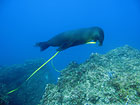

 | |||||||||||||||||
|
|
Journals 2007/2008Beth Jewell
January 18, 2008 We finally arrived at a dive site that was free of strong currents and good for snorkeling. I was going to get to join the divers in the water and see what they were seeing. The dive sites are chosen for their ledges and this site was no different. Snorkeling and diving in the Galápagos is unique. The walls of the islands have ledges that are 3-5 meters wide. Turn away from the wall and nothing but deep blue. The drop off is quick and goes down for forever.
Once we entered the water, three divers immediately went down, leaving me to bob on the surface by myself. One diver looked back at me and signaled that there was a shark around. I couldn't find it. After getting over being spooked by my zipper pull, I pointed my head in the direction of the wall and began to look at all the fish. Schools of Razor Surgeonfish swam about the ledge, looking to graze on algae. King Angel fish swam by themselves and didn't seem to be too afraid of me as I swam down to take their picture. I saw juvenile and adult hogfish, a primary barnacle predator. Gobies, damselfish, blue-chin parrotfish, and a rainbow wrasse are some of the other fish I could identify. Eventually I began to notice the corals. The corals here in the Galápagos are not reef building corals so individual corals are easy to distinguish. I could see the bleaching in the corals that Jim is studying. Later, back on the boat, Jim showed me pictures he has taken of the corals. His pictures show that the bleaching is species specific. Some of the corals have barnacles settling on them in less than six months time. This will make it difficult for the corals to come back. This is just a small part of the big ecosystem picture. A La Niña event occurs causing the water temperature to drop. Various species of coral bleach, allowing barnacles to colonize on them. The frequency of hogfish will increase, as they are predators of the barnacles. This is the puzzle Jon and his team is trying to put together. The highlight of my dive was the seal lions that came by to check me out. The first one that came by caught me by surprise. He did some somersaults for me and swam up to my mask. I watched one swim at the surface, looking for a place to climb up on the rocks. Once he found a suitable spot he clumsily climbed out of the water. It was surreal to watch this sea lion lay on the cliff, 3 meters from me while I bobbed in the water. Other sea lions swam by me long enough to see what I was doing. The divers later told me that the sea lions had been getting in their way, playing with their measuring tape.
Remember that ledge and the drop off? That is where sharks like to swim about looking for an easy meal. I was lucky enough to see both a white tip and black tip reef shark. They were smaller than I though they would be and not as scary. When I turned with my fins to take a picture, the white tip reef shark swam away. I was relieved to learn they were more afraid of me than I was of them. After the first two dives we had another long passage to the next dive site. I sat up on the bow looking for that elusive sperm whale. Didn't see a whale but was entertained by a few manta rays doing flips, blue-footed boobies dive bombing into the ocean, and one flying fish sail across the surface. Jon Witman's Dive Notes:
|
||||||||||||||||



